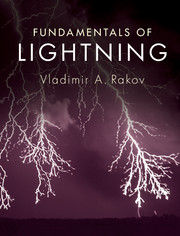Book contents
- Frontmatter
- Dedication
- Contents
- Preface
- 1 Types of lightning discharges and lightning terminology
- 2 Incidence of lightning to areas and structures
- 3 Electrical structure of thunderclouds
- 4 Properties of the downward negative lightning discharge to ground
- 5 Calculation of lightning electromagnetic fields
- 6 Modeling of the lightning return stroke
- 7 Measurement of lightning electric and magnetic fields
- 8 Electromagnetic methods of lightning location
- 9 Lightning damaging effects and protective techniques
- Appendices
- Appendix 1 How is lightning initiated in thunderclouds?
- Appendix 2 Reconstruction of sources from measured electrostatic field changes
- Appendix 3 Derivation of exact equations for computing lightning electric and magnetic fields
- Appendix 4 Compact intracloud discharges (CIDs)
- Appendix 5 Is it true that lightning never strikes the same place twice?
- Appendix 6 Is it possible to use lightning as an energy source?
- Appendix 7 Lightning safety
- Appendix 8 Lightning makes glass
- Appendix 9 Bibliography on triggered lightning experiments and natural lightning observations at Camp Blanding, Florida (1995–2014)
- Glossary
- References
- Index
Appendix 7 - Lightning safety
from Appendices
Published online by Cambridge University Press: 05 April 2016
- Frontmatter
- Dedication
- Contents
- Preface
- 1 Types of lightning discharges and lightning terminology
- 2 Incidence of lightning to areas and structures
- 3 Electrical structure of thunderclouds
- 4 Properties of the downward negative lightning discharge to ground
- 5 Calculation of lightning electromagnetic fields
- 6 Modeling of the lightning return stroke
- 7 Measurement of lightning electric and magnetic fields
- 8 Electromagnetic methods of lightning location
- 9 Lightning damaging effects and protective techniques
- Appendices
- Appendix 1 How is lightning initiated in thunderclouds?
- Appendix 2 Reconstruction of sources from measured electrostatic field changes
- Appendix 3 Derivation of exact equations for computing lightning electric and magnetic fields
- Appendix 4 Compact intracloud discharges (CIDs)
- Appendix 5 Is it true that lightning never strikes the same place twice?
- Appendix 6 Is it possible to use lightning as an energy source?
- Appendix 7 Lightning safety
- Appendix 8 Lightning makes glass
- Appendix 9 Bibliography on triggered lightning experiments and natural lightning observations at Camp Blanding, Florida (1995–2014)
- Glossary
- References
- Index
Summary
Lightning safety experts (Holle et al., 1999; Walsh et al., 2013) have presented their consensus views of personal safety from lightning that can be summarized as follows:
• No place is absolutely safe from the lightning threat; however, some places are much safer than others.
• Large enclosed structures (substantially constructed buildings) are much safer than smaller or open structures. The risk of lightning injury depends on whether the structure incorporates lightning protection, the construction materials used, and the size of the structure.
• In general, fully enclosed metal vehicles such as cars, trucks, buses, vans, fully enclosed farm vehicles, etc. provide good shelter from lightning.
• One should avoid being outside in the presence of lightning. When the lightning threat develops, go quickly to a substantial building or fully enclosed vehicle.
• When inside a building one should avoid the use of a corded telephone or any contact with conductive paths with exposure to the outside, such as wiring or plumbing.
• Where groups of people are involved, an action plan for getting to a lightning-safe place must be made in advance by the responsible individuals.
Following these relatively simple personal safety rules can considerably reduce the chances of being killed or injured by lightning.
Figure A7.1 shows a triggered-lightning discharge (via a 7 m air gap) to a fully enclosed car with a live rabbit inside. The experiment was carried out on December 20, 1980 at the Kahokugata lightning triggering facility in Japan. The strike terminated on the radio antenna, the top 30 cm of which was melted and vaporized. Also, the strike melted a hole (1 cm in diameter) in the car body near the base of the antenna. However, the rabbit inside the car was not harmed, which confirms that fully enclosed vehicles generally provide good shelter from lightning.
Many lightning strike victims can survive their encounter with lightning, especially with timely medical treatment, including cardiopulmonary resuscitation (CPR). Individuals struck by lightning do not carry an electric charge, so it is safe to touch them, and indeed it is imperative to do so in order to administer CPR.
Further information on locations that are unsafe during thunderstorms is given by Walsh et al. (2013).
- Type
- Chapter
- Information
- Fundamentals of Lightning , pp. 215 - 217Publisher: Cambridge University PressPrint publication year: 2016



